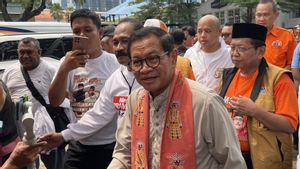JAKARTA - Prevention and treatment measures both play an important role in the midst of a surge in COVID-19 cases. This step is an effort to prepare Indonesia for the potential tidal wave of the pandemic.
Responding to the Corona virus infection that continues to threaten, there are at least four main things that a number of countries are doing to deal with the pandemic, namely controlling citizen mobility, implementing health protocols, COVID-19 vaccination, and treatment. The last aspect, namely the success of treatment, is the world's great hope in dealing with the corona outbreak.
In the midst of a surge in cases of COVID-19 infection caused by the Omicron variant, WHO recommends a new drug for patients with severe and critical symptoms. The development and availability of COVID-19 drugs is also the world's hope in dealing with the Corona pandemic.
The World Health Organization (WHO) regularly updates COVID-19 treatment guidelines in line with the development of treatment for Corona Virus infection. On January 14, 2022, WHO published a guideline document for treating COVID-19 patients. In the eighth document entitled "Therapeutics and COVID-19: Living Guideline" there are 14 new recommendations regarding the treatment of COVID-19, one of which is a new drug for patients with severe and critical symptoms.

The discussion of drugs for COVID-19 patients is a crucial part of handling the pandemic. In Indonesia, there are rules that underlie claims for reimbursement of patient care costs, namely the Decree of the Minister of Health Number HK.01.07/MENKES/5673/2021.
Treatment costs borne by the government through the Ministry of Health (Kemenkes) include service administration, inpatient room accommodation, doctor services, isolation rooms, supporting examinations, medicines and medical devices, and personal protective equipment (PPE).
The Ministry of Health divides the types of drugs used in Indonesia separately into three parts, namely multivitamins, symptomatic drugs, and antivirals. Two types of vitamins that must be given to all patients with various symptoms are vitamins C and D.
While symptomatic drugs are adjusted to the type of symptoms that appear. The most common symptom that appears is fever, so the type of drug given is paracetamol, usually plus a pain reliever. Especially for antiviral drugs, the type of drug is adjusted to the degree of severity. Especially for patients with moderate to severe symptoms, oxygenation is added to their treatment.
The five antiviral drugs used in Indonesia are favipiravir, molnupiravir, nirmatevir, ritonavir, and remdesivir. For patients with moderate symptoms, anticoagulant treatment is also given to prevent blood clots. Meanwhile, patients with severe symptoms need to get corticosteroids and IL-6.
For patients in Indonesia, the stock of drugs available at the health office per province is adequate. Data as of January 28, 2022, the government has provided stock of five types of drugs, namely favipiravir (6.69 million pills), remdesivir (233,700 vials), tocilizumab 400 mg/20 ml (303 vials), tocilizumab 80 mg/4 ml (748 vials). ), and multivitamins (6.44 million grains).
Drug Variants
The development of clinical research on drugs for COVID-19 patients continues to this day. The eighth edition of "Therapeutics and COVID-19: Living Guideline" prepared by WHO describes the latest developments in the use of drugs, including which drugs are no longer recommended.
There are three new recommendations from WHO regarding the treatment of COVID-19. First, the drug baricitinib can be used as an alternative to IL-6 for patients with severe to critical symptoms. Use of the drug baricitinib or IL-6 in combination with corticosteroids.

Second, recommendations for alternative drugs to ruxolitinib and tofacitinib for patients with severe and critical symptoms. For patients with severe and critical symptoms, WHO strongly recommends baricitinib over two other drugs, namely ruxolitinib and tofacitinib. Third, the alternative recommendation for asymptomatic patients is sotrovimab.
In addition to the three new findings, WHO also emphasized that various types of drugs/therapy should be prohibited from being used for COVID-19 patients, except in the context of clinical trials. In the seventh edition of the document “Therapeutics and COVID-19: Living Guideline” released on December 7, 2021, convalescent plasma therapy should be discontinued in its entirety.
Self Isolation
Consumption of drugs for patients with confirmed COVID-19, especially patients who are self-isolating at home, cannot be done arbitrarily without the monitoring of medical personnel. Each type of drug has side effects so the dose given must be measured.
Of the thousands of active cases, only 12 percent of patients are hospitalized. This means that currently patients are predominantly self-isolating patients or those using centralized isolation facilities. For self-isolated patients, monitoring of medical conditions is absolutely necessary, especially the administration of appropriate drugs.
The Ministry of Health has prepared drug packages for asymptomatic and mild symptomatic patients, especially self-isolated patients, which can be accessed via telemedicine. The package for asymptomatic patients contains 10 multivitamins C, B, E, and Zinc. Meanwhile, packages for patients with mild symptoms consist of multivitamins C, B, E, and Zinc (20 pills), favipiravir 200 mg or malnupiravir 200 mg (40 pills), and paracetamol 500 mg (20 pills).
Procurement of medicine for COVID-19 patients is as important as vaccination, especially for patients who experience symptoms. Many lives can be saved through appropriate treatment or therapy, ranging from multivitamins, symptomatic drugs, to antivirals.
According to the Shinology Lab release. Japan quoted by Reuters, currently the oral drugs produced by Merck and Pfizer have been bought up and ordered by rich countries in Europe and America. Even Japan only got 1.6 million doses of molnupiravir by paying 1.2 billion US dollars. The shortfall will be met by Shionogi's oral medicine.

Middle-income countries get from pharmaceutical companies that get voluntary licensing (VL) from patent holders. For example, Indonesia purchased molnupiravir from Hetero Labs Ltd, India.
Learning from the case of the COVID-19 vaccine, which was hampered when producing countries were hit by a large wave of cases, the government's steps to ensure drug availability were correct. Namely, encouraging drug production in Indonesia. Of course, not only packaging, but also capable of producing raw materials.
Until now research on drugs is still ongoing. WHO will provide new recommendations if medical evidence is found related to the type of COVID-19 drug, including banning the use of drugs that are considered dangerous and do not have a significant impact. The development of treatment research and the availability of COVID-19 drugs is the world's hope in dealing with the Corona pandemic, which is not over yet.
The English, Chinese, Japanese, Arabic, and French versions are automatically generated by the AI. So there may still be inaccuracies in translating, please always see Indonesian as our main language. (system supported by DigitalSiber.id)








